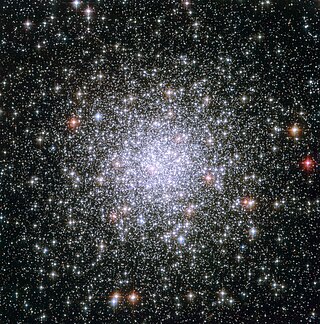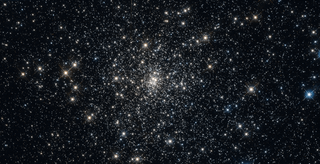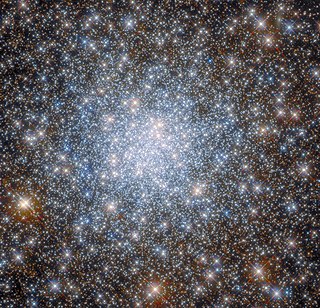Related Research Articles

The Sagittarius Dwarf Spheroidal Galaxy (Sgr dSph), also known as the Sagittarius Dwarf Elliptical Galaxy, is an elliptical loop-shaped satellite galaxy of the Milky Way. It contains four globular clusters in its main body, with the brightest of them—NGC 6715 (M54)—being known well before the discovery of the galaxy itself in 1994. Sgr dSph is roughly 10,000 light-years in diameter, and is currently about 70,000 light-years from Earth, travelling in a polar orbit at a distance of about 50,000 light-years from the core of the Milky Way. In its looping, spiraling path, it has passed through the plane of the Milky Way several times in the past. In 2018 the Gaia project of the European Space Agency showed that Sgr dSph had caused perturbations in a set of stars near the Milky Way's core, causing unexpected rippling movements of the stars triggered when it moved through the Milky Way between 300 and 900 million years ago.

Omega Centauri is a globular cluster in the constellation of Centaurus that was first identified as a non-stellar object by Edmond Halley in 1677. Located at a distance of 17,090 light-years, it is the largest known globular cluster in the Milky Way at a diameter of roughly 150 light-years. It is estimated to contain approximately 10 million stars, with a total mass of 4 million solar masses, making it the most massive known globular cluster in the Milky Way.

Messier 19 or M19 is a globular cluster in the constellation Ophiuchus. It was discovered by Charles Messier on June 5, 1764 and added to his catalogue of comet-like objects that same year. It was resolved into individual stars by William Herschel in 1784. His son, John Herschel, described it as "a superb cluster resolvable into countless stars". The cluster is located 4.5° WSW of Theta Ophiuchi and is just visible as a fuzzy point of light using 50 mm (2.0 in) binoculars. Using a telescope with a 25.4 cm (10.0 in) aperture, the cluster shows an oval appearance with a 3′ × 4′ core and a 5′ × 7′ halo.

Messier 22 or M22, also known as NGC 6656 or the Great Sagittarius Cluster, is an elliptical globular cluster of stars in the constellation Sagittarius, near the Galactic bulge region. It is one of the brightest globulars visible in the night sky. The brightest stars are 11th magnitude, with hundreds of stars bright enough to resolve with an 8" telescope. It is just south of the sun's position in mid-December, and northeast of Lambda Sagittarii, the northernmost star of the "Teapot" asterism.

Messier 53 is a globular cluster in the Coma Berenices constellation. It was discovered by Johann Elert Bode in 1775. M53 is one of the more outlying globular clusters, being about 60,000 light-years (18.4 kpc) light-years away from the Galactic Center, and almost the same distance from the Solar System. The cluster has a core radius (rc) of 2.18 pc, a half-light radius (rh) of 5.84 pc, and a tidal radius (rtr) of 239.9 pc.

Messier 55 is a globular cluster in the south of the constellation Sagittarius. It was discovered by Nicolas Louis de Lacaille in 1752 while observing from what today is South Africa. Starting in 1754, Charles Messier made several attempts to find this object from Paris but its low declination meant from there it rises daily very little above the horizon, hampering observation. He observed and catalogued it in 1778. The cluster can be seen with 50 mm binoculars; resolving individual stars needs a medium-sized telescope.

Messier 69 or M69, also known NGC 6637, and NGC 6634, is a globular cluster in the southern constellation of Sagittarius. It can be found 2.5° to the northeast of the star Epsilon Sagittarii and is dimly visible in 50 mm aperture binoculars. The cluster was discovered by Charles Messier on August 31, 1780, the same night he discovered M70. At the time, he was searching for an object described by Nicolas-Louis de Lacaille in 1751–2 and thought he had rediscovered it, but it is unclear if Lacaille actually described M69.

PSR J1748−2446ad is the fastest-spinning pulsar known, at 716 Hz, or 42,960 revolutions per minute. This pulsar was discovered by Jason W. T. Hessels of McGill University on November 10, 2004, and confirmed on January 8, 2005.

Palomar 12 is a globular cluster in the constellation Capricornus, and is a member of the Palomar Globular Clusters group.

Palomar 1 is a globular cluster part of the Palomar group in the constellation Cepheus in the halo possibly in the Outer Arm of the Milky Way galaxy. First discovered by George O. Abell in 1954 on the Palomar Survey Sky plates, it was catalogued as a globular cluster. At 6.3 to 8 Gyr, it is a very young cluster when compared to the other globular clusters in the Milky Way. It is a relatively metal-poor globular with [Fe/H] = −0.60. It is likely that Palomar 1 has a similar evolutionary history to the Sagittarius dwarf companion globular Terzan 7, that is, it may have once been associated with a dwarf spheroidal galaxy that was later destroyed by tidal forces.
In astronomy, galactocentrism is the theory that the Milky Way Galaxy, home of Earth's Solar System, is at or near the center of the Universe.

Terzan 7 is a sparse and young globular cluster that is believed to have originated in the Sagittarius Dwarf Spheroidal Galaxy and is physically associated with it. It is relatively metal rich with [Fe/H] = -0.6 and an estimated age of 7.5 Gyr. Terzan 7 has low levels of nickel which supports its membership in the Sag DEG system since it has a similar chemical signature. It has a rich population of blue stragglers that are strongly concentrated toward the center of Terzan 7. It has an average luminosity distribution of Mv = -5.05. It has a half-light radius (Rh) of 6.5pc.

Terzan 5 is a heavily obscured globular cluster belonging to the bulge of the Milky Way galaxy. It was one of six globulars discovered by French astronomer Agop Terzan in 1968 and was initially labeled Terzan 11. The cluster was cataloged by the Two-Micron Sky Survey as IRC–20385. It is situated in the Sagittarius constellation in the direction of the Milky Way's center. Terzan 5 probably follows an unknown complicated orbit around the center of the galaxy, but currently it is moving towards the Sun with a speed of around 90 km/s.
Agop Terzan was a Turkish-French astronomer of Armenian descent. Known for his work on globular clusters, he is the author of the Terzan Catalogue. Terzan spent most of his life in Lyon, France.

NGC 6256 is a globular cluster of stars in the southern constellation of Scorpius. It was discovered by the Scottish astronomer James Dunlop on Aug 2, 1826. In J. L. E. Dreyer's New General Catalogue annotation it is described as, "very faint, very large, very gradually bright in the middle, well resolved clearly consisting of stars." The cluster is located at a distance of 22 thousand light-years (6.8 kpc) from the Sun.

NGC 4147 is the New General Catalogue identifier for a globular cluster of stars in the northern constellation of Coma Berenices. It was discovered by English astronomer William Herschel on March 14, 1784, who described it as "very bright, pretty large, gradually brighter in the middle". With an apparent visual magnitude of 10.7, it is located around 60,000 light years away from the Sun at a relatively high galactic latitude of 77.2°.

NGC 5053 is the New General Catalogue designation for a globular cluster in the northern constellation of Coma Berenices. It was discovered by German-British astronomer William Herschel on March 14, 1784 and cataloged as VI-7. In his abbreviated notation, he described it as, "an extremely faint cluster of extremely small stars with resolvable nebula 8 or 10′ diameter, verified by a power of 240, beyond doubt". Danish-Irish astronomer John Louis Emil Dreyer reported in 1888 that the cluster appeared, "very faint, pretty large, irregular round shape, growing very gradually brighter at the middle".

NGC 6638 is a globular cluster in the constellation Sagittarius. It is magnitude 9.5 and diameter 2 arc minutes, class VI. It is a half degree east of Lambda Sagittarii. It is a member of the Milky Way.

NGC 7492 is a globular cluster in the constellation Aquarius. It was discovered by the astronomer William Herschel on September 20, 1786. It resides in the outskirts of the Milky Way, about 80,000 light-years away, more than twice the distance between the Sun and the center of the galaxy, and is a benchmark member of the outer galactic halo. The cluster is immersed in, but does not kinematically belong to, the Sagittarius Stream.
References
- ↑ Frommert, Hartmut; Kronberg, Christine (1979-01-15). "List of Common Deep Sky Catalogs". SEDS Messier Database. Retrieved 2024-07-17.
- 1 2 3 4 5 6 Wilson, Barbara (1999-05-13). "Obscure Globular Clusters of the Milky Way: Terzan Clusters and the Faintest Globular UKS-1". Astronomy Mall. Retrieved 2024-07-17.
- ↑ Terzan, Agop (1966). "Un nouvel amas globulaire dans la region du centre de la Voie lactee". Comptes Rendus de l'Académie des Sciences, Série B (in French). 263: 221–222. Bibcode:1966CRASB.263..221T . Retrieved 2024-07-17.
- ↑ Terzan, Agop (1967). "Un nouvel amas globularie dans la region centrale de la Galaxie". Comptes Rendus de l'Académie des Sciences, Série B (in French). 265: 734–736. Bibcode:1967CRASB.265..734T . Retrieved 2024-07-17.
- ↑ Terzan, Agop (1968). "Six nouveaux amas stellaires (Terzan 3-8) dans la region du centre de la Voie lactee et les constellations du Scorpion et du Sagittaire". Comptes Rendus de l'Académie des Sciences, Série B (in French). 267: 1245–1248. Bibcode:1968CRASB.267.1245T . Retrieved 2024-07-17.
- ↑ Terzan, Agop (1971). "Four new star clusters in the direction of the central area of the Galaxy". Astronomy and Astrophysics. 12: 477–481. Bibcode:1971A&A....12..477T. ISSN 0004-6361 . Retrieved 2024-07-17.